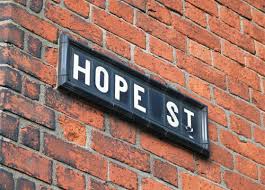Energetic Connection February 22 2013
 Hope is a four-letter word.
Hope is a four-letter word.
The dictionary defines hope as “desire accompanied with expectation for fulfillment.” My definition is similar, yet much less accommodating and certainly not so nice! Here it is:
H stands for helplessness. O stands for oppressed. P stands for passive. E stands for expectation.
I stay away from that word, recently replacing it with “trust.” Trust carries a higher vibration, and “hope” is often just a mere step above victim, breeding powerlessness like a rabbit.
That’s part of a 2010 repost from my blog series on self-mastery and the levels of consciousness. SInce that time, so much more has been uncovered about languaging, visualization, brain waves, subconscious states and responses as they relate to our human potential to create and manifest.
Consider our constant state of transitional and evolutionary experiences: many of us are in a sort of post-pinnacle-limbo-state-of-being and even a bit of hopelessness right now. What we thought we knew last year, in fact the shift that so many looked upon hopefully, has not actualized in our 3D world. It’s just not manifest, here, now, in the way so many believed it would or could be.
Even so, and even more importantly now, it is our “job” to sustain the vision of peace, ascension, sanctuary, evolution, the betterment of mankind and our relationship to the planet…however we might “see it” as individuals.
Instead of hoping it will be, trust that it already exists.
The Western Mystery traditions use visioning practices to explore the inner realms, to invoke the divine and create sanctuary, often to evoke positive outcomes for the greater good. Essentially they use magic to hold ceremonial space, a picture of the inner temple and other realms.
There is no hoping involved. It’s an exercise of certainty and trust in both individuals and the group to make real what exists on the astral planes.
Gregg Braden’s 2004 audio series on the “Lost Mode of Prayer,” speaks to an ancient praying ritual based in our capacity to “act as if” something is currently happening–rather than positioning it in our minds as something nearly unachievable or something we have to strive or reach for. By acknowledging and trusting, we breakthrough the illusions of our 3D world and into limitlessness.
Even neuro-science knows the difference between hope and trust. Here’s a related excerpt from a coaching blog. Read more at Validate Your Life:
“…words have a huge impact on the neurology of which cells get triggered and how intensely and frequently certain brain cells get activated, the culmination of that could be a habit, or thought, and/or emotion.
The problem is that people think “I hope” and “I trust” are equal; linguistically they may be fairly synonymous, but neuroscientifically “trust” and “hope” are massively different. . When we use trust, we develop a pattern of achieving what we “trust will happen” because it’s a more selective usage. You can throw “I hope” in front of anything, so by using “I hope” you set yourself up for disappointment, it’s in the linguistic technology of the defunctory word! But “I trust”, implies you’ve done something to strengthen and almost make certain the occurrence of said interest and your cerebral neurons know this!”
Although the dictionary definition of hope can be construed to appear positive, most people avoid the key step of actualizing what they “hope” for, and instead pray from a place of lack.
Wishing for things, believing in things, talking about things, these are not only ways we imprison our creative potential in the mental realms, they are also ways we apathetically live our lives in “hope.”
Passive, un-actualized hope is based on thinking from the abyss of our spiritual memory loss. Like a lost love, hope is grief for some desired outcome that was never acquired. It’s a state of no responsibility, self-suppressed qualities, and yearning. In this place of passive desire, we are emotionally numb, dissatisfied and envious for what we lack.
Most of us are fully capable of envisioning drama or negative outcomes, all the while praying for something different and wondering why it does not manifest. Why not change the picture you hold in your mind, beginning to envision the change you want to see in your life or the world.
At some point on the road of self-realization we begin to recognize who we are. We look into that still pool of water every day, entraining ourselves with knowingness.
One day we actualize what we believe or know. Rather than waiting for someone to wave the magic wand of fantastical change, rather than listening to a repetitive, mental mantra of passive “hope,” instead we get off the bench, begin to set intentions, take a little action, and trust we have the power within us to create everything.
Remember: sustain the vision.

